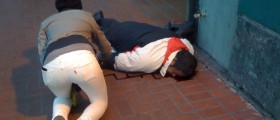
Epilepsy is a condition which resultsin repeating seizures, appearing throughout one's life. The seizuresrelated to epilepsy take place due to electric activity disruptionsin the brain. Once epilepsy attacks occur, therefore, the affectedperson can change his/her body movements, levels of awareness or havehis/her senses, emotions or overall behavior altered.
Some seizures related to epilepsymanifest through loss of consciousness and appearance of convulsions.Therefore, people who experience these, taking into considerationthat these appear randomly, may get seriously hurt, depending on theactivities they are involved in during the seizure.
Epilepsy in Human Body
About 460,000 people suffer fromepilepsy in the UK nowadays. This condition commonly appears inchildhood and most affected individuals manage to overcome itnaturally by the time they reach adulthood. Unfortunately, some lessfortunate people continue suffering from epileptic seizuresthroughout their lives.
Depending on the type of seizures,epileptic attacks can manifest through various symptoms. Some of themost common ones for partial seizures, being the attacks which affecta single area of the brain, are deja vu, feelings of joy or fearwhich cannot be explained, numbness, tingling in some parts of thebody, the pins and needles sensation, involuntary, jerky motions orspasms of certain body parts, and hallucinations involving flashingor colored lights.
If the partial seizure affects largerportions of the brain, these attacks are called complex partialseizures and they manifest through involuntary movements of the lipsor the mouth, fiddling, fidgeting and other such repetitive actions,wandering around, kicking with the legs and moving the arms violentlyand talking gibberish.
Finally, if the seizures affect theentire brain due to electrical irregularities appearing randomlyaround the brain, the seizures are called generalized and result in aloss of consciousness and memory.
These seizures are further divided intotype, the first of which is the tonic clonic-one where the patientloses his/her consciousness, experiences muscle stiffness, producesstrange sounds, loses balance, falls to the ground and bite his/hercheeks or tongue. Also, the clonic part of this seizure type takesplace afterwards, triggering jerking of the body, losing bladder andbowel control and paleness.
The second type of generalized seizuresare atonic ones where the affected person loses the control overmuscles completely, relaxing them and falling to the ground, oftengetting injured. If a seizure is myoclonic, the whole body of theaffected person starts moving in a jerky manner. These seizurescommonly appear during the morning, right after an epileptic personwakes up. The seizures can also appear during sleep.
Many epileptic people manage to controland suppress their seizures by taking medications or undergoingsurgery of the brain. Others can prevent injuries and other suchincidents by paying attention to the symptoms which appear before anattack. These signs can be lack of sleep, skipping a dose of themedication, skipping meals, taking alcohol or illegal drugs, gettingexposed to strong or flickering lights, undergoing hormonal changes,being under stress, having a fever or taking some other medications.
Risk of Epilepsy and Gymnastics
People with epilepsy rarely suffer frominjuries caused by seizures during their sport activity. In fact, thechances of epileptics getting hurt while they are taking a shower, byfalling onto the bathroom tiles, are much greater than sustaininginjuries by falling onto a grass field or ice. However, epilepticpeople need to bear in mind that the seizures characteristic fortheir condition can appear anytime and anywhere.
Therefore, they should not swim, climbor participate in any sport activities alone. The same goes forgymnastics. Rather, they should perform these physical activitieswhile being accompanied by others who can intervene should theseizures appear. Since some gymnastic disciplines involve spendingtime high above the ground, people who have epilepsy should securethemselves with safety ropes or soft mats in case they experience aseizure during their workouts.
However, seizures are rarely provokedby physical activity and many people with epilepsy participate insports such as baseball, ice hockey, basketball and numerous otheractivities of this type. Moreover, some epileptics are evenprofessional athletes.
Simply, if the person takes care ofhim/herself well and never engages into risky physical activitiesalone, he/she can be safe during sports of all types. Nevertheless,it is recommended that those who experience serious attacks stay awayfrom risky sports where they can get hurt once their lose theirconsciousness or balance.
In general, epilepsy is a conditionwhich manifests through seizures which trigger various symptoms inpeople, ranging from mood changes to fainting and jerky movements ofthe limbs and muscles, accompanied with the total loss of memory.However, people who suffer from epilepsy can excel at sports such asgymnastics, provided that they keep themselves completely safe andadequately protected while performing such advanced physicalactivities.
















Your thoughts on this
Loading...